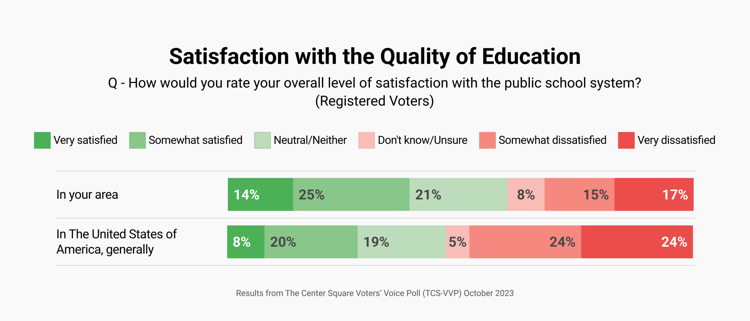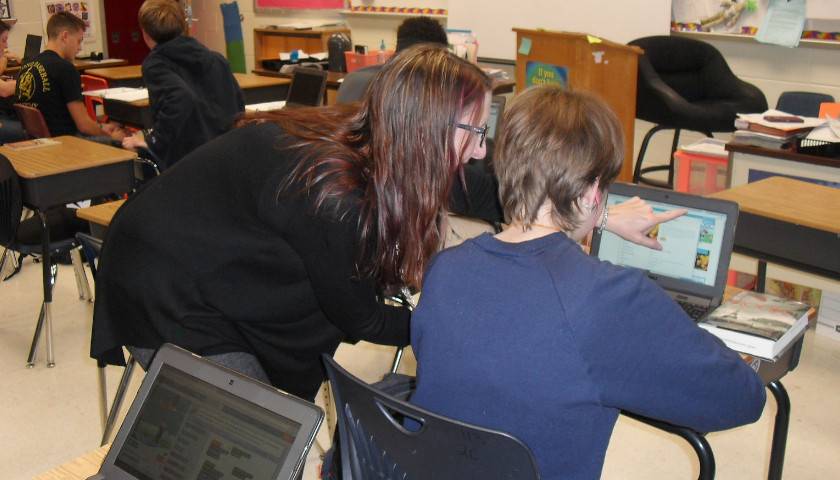by Brendan Clarey
A new poll shows a large disparity between how voters think of their local public school system and the nation’s school system as a whole, signaling frustration with larger education issues as opposed to more area-specific ones.
Respondents’ approval of their local schools held constant in the most recent The Center Square Voters’ Voice Poll, which was conducted by Noble Predictive Insights.
The poll found almost half of voters disapprove of the nation’s education system as schools become a battleground for culture wars.
The poll of 2,605 registered voters includes 1,035 Republicans, 1,074 Democrats, and 496 true Independents, and is among the most comprehensive in the country. It found that 39% of those polled said they were either somewhat or very satisfied with their local school.
The poll’s margin of error for registered voters is 1.9%.
Gaps as large as 13 percentage points exist between the satisfaction of local schools and school systems across the nation, according to poll data, signaling frustrations with the system outside voters’ school districts.

The Voter’s Voice poll conducted in late July found that 39% of all voters were satisfied with their local public school, so voters have held steady on their satisfaction even into the school year, with 39% of respondents in October approving of local schools.
Interestingly, independent voters have changed their stance on local schools with a move toward more moderate opinions. Independents reported last month that they were 27% satisfied and 33% dissatisfied, down from 34% satisfaction and 43% dissatisfaction this summer.
Over the summer, 22% of independents said they were neutral or neither dissatisfied nor satisfied with their local schools. In October, 31% of independents took a neutral stance on their local school’s performance, and 27% took a favorable stance, according to the poll.
Democrats and Republicans reported similar degrees of satisfaction regarding their local schools as they did over the summer, with 34% of Republicans saying they were satisfied and 46% of Democrats saying the same.
But more broadly, Americans are less satisfied with public schools across the country, according to a new question.
The October poll found that only 28% of registered voters were satisfied or very satisfied with the country’s schools generally. It also found that almost half of voters, 48%, were somewhat dissatisfied or very dissatisfied. Of those, 24% were somewhat dissatisfied, and 24% were very dissatisfied with public schools in general.
Republicans were most disapproving of public schools nationwide, with 60% saying they were somewhat or very dissatisfied compared to 36% of Democrats and 45% of independents. Only 16% of independents indicated they were satisfied with public schools in the U.S., lower than Republicans at 21% and Democrats at 37%.
Voters in different regions of the United States also reported differing levels of satisfaction with schools, broadly speaking, with 53% of voters in the Western region of the country reporting the highest dissatisfaction in schools, followed by 50% in the South, 45% in the Midwest and 40% in the Northeast.
Male respondents were more likely to signal satisfaction with the nation’s school system than female respondents, 30% to 23%. Male and female dissatisfaction was much closer, with men at 48% and women at 49%.
Some of the discontent for public schools has possibly fueled the push for school choice options in the past year, with more states allowing students to use public funds for private schools.
Questions about the quality of education could also explain the rise of advocacy groups like Moms for Liberty and other parent groups that have vocally demanded the removal of sexually explicit material from classrooms and school libraries.
Advocates say allowing LGBTQ+ students to read the material is affirming.
Another hot-button issue that has roiled communities relates to school policies governing gender-related issues, including sex education classes and transgender student participation in sports.
The Voter’s Voice poll found this summer that two-thirds of respondents do not want transgender females competing in women’s sports, according to The Center Square.
Men were more likely than women to support a ban on transgender females, but 52% of all voters strongly opposed allowing transgender females to compete on teams with biological females.
– – –
Brendan Clarey is a contributor to The Center Square.
Photo “Teacher and Student” by Virginia Department of Education. CC BY 2.0.




